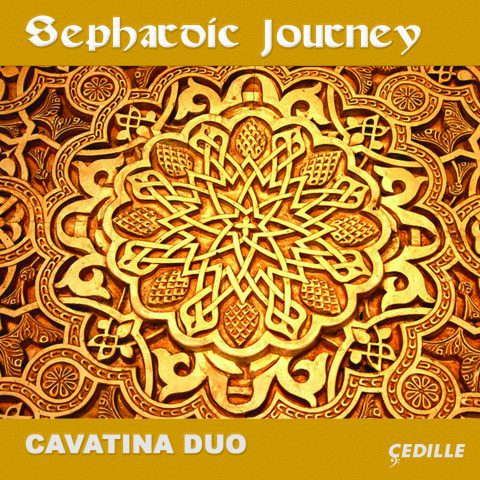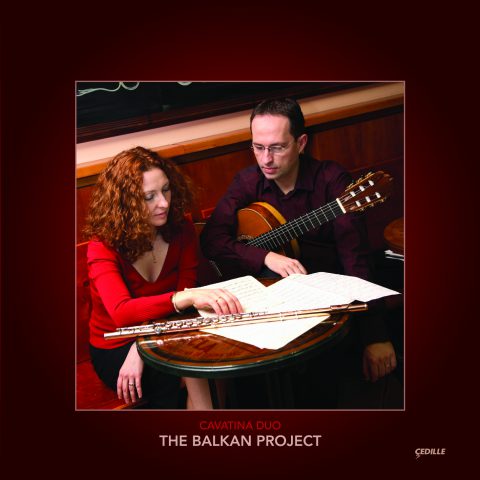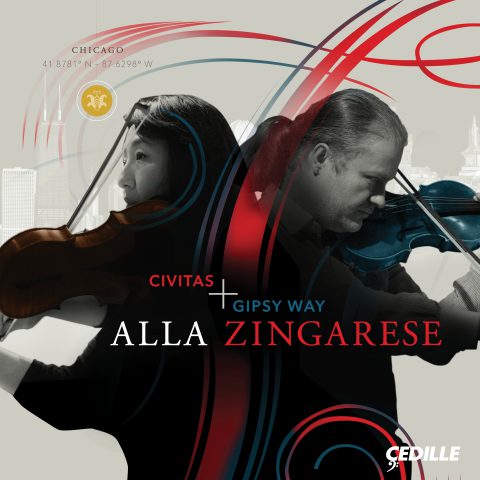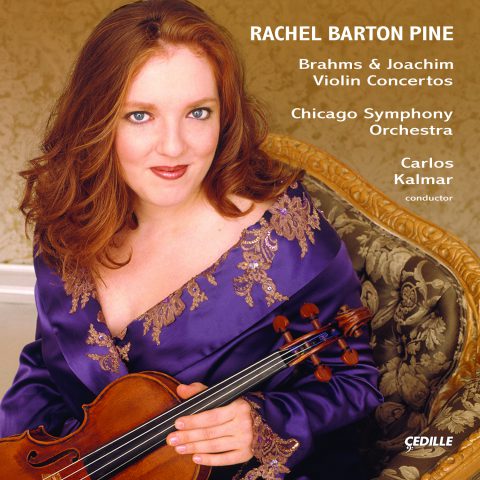| Subtotal | $18.00 |
|---|---|
| Tax | $1.85 |
| Total | $19.85 |
Store
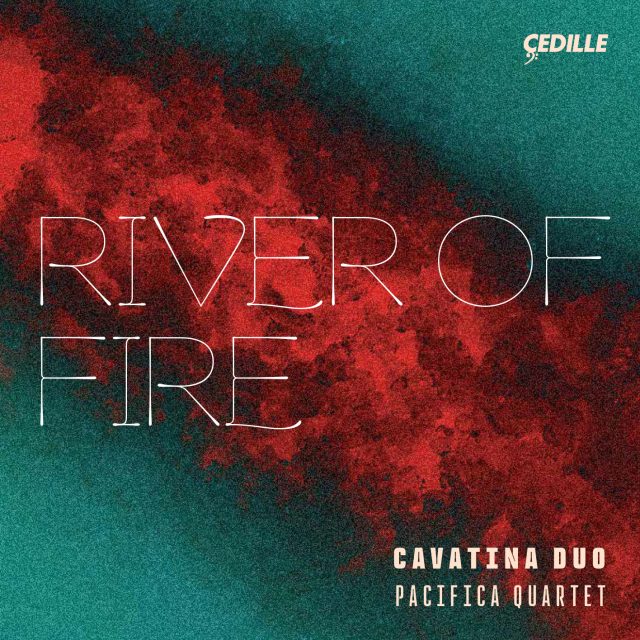
The Cavatina Duo — renowned Bosnian guitarist Denis Azabagić and Spanish flutist Eugenia Moliner — collaborates with the Grammy Award-winning Pacifica Quartet on River of Fire, an album featuring world-premiere recordings of five original compositions that bridge classical traditions and Gypsy influences.
The works, composed for the duo by Clarice Assad, Sérgio Assad, Matthew Dunne, Stacy Garrop, and Atanas Ourkouzounov, draw on the music and history of the Romani diaspora, weaving a narrative of migration, displacement, and resilience. The Cavatina Duo is committed to innovation and cultural exploration with a deep understanding of historical influences, from Balkan and Spanish Gypsy music to Indian classical traditions, emphasizing an East-to-West and West-to-East exchange, echoing Gypsy music’s historic migration.
Each movement of Garrop’s Romani Songs explores a different aspect of Romani music, including an original arrangement of Ederlezi, a traditional Romani song depicting the changing of seasons. Garrop was inspired by Romani dancers and her work, performed with cellist Brandon Vamos, incorporates clapping, stomping, and the guitar as percussion.
Violinist Simin Ganatra joins in Sérgio Assad’s Contos Ciganos, a work that encapsulates musical influences from global cultures that permeate the Romani sound. It follows the historical dissemination of the Romani people from the traditional dances of India’s Punjab region to Gelem Gelem, a Romani anthem inspired by the unique cultural blend found in northeastern Brazil.
Ourkouzounov’s Raga Ibraima blends Balkan and Romani musical influences with the traditional Indian raga. This piece pays homage to Ivo Papazov, a Bulgarian-Romani clarinetist who garnered international recognition for bringing his unique musical heritage to “wedding band” music in Stambolovo, Bulgaria.
Dunne composed Three Artisans in memory of flutist Tal Perkes. Its three movements — The Painter, The Architect, and The Flute Player — acknowledge Perkes’s life pursuits while weaving in European jazz, Flamenco, and Romani musical influences.
The Pacifica Quartet joins for Grammy Award-nominated Brazilian-American composer Clarice Assad’s Four Scenes, which depict the Romani experience of being in constant motion, the fleeting comfort of temporary homes, and the anxiety of instability.
River of Fire was produced and engineered by the Grammy-winning team of James Ginsburg and Bill Maylone. The album was recorded on January 4–5 and June 5–6, 2024 in Auer Hall at Indiana University Bloomington.
Preview Excerpts
STACY GARROP (b. 1969)
Romani Songs
SÉRGIO ASSAD (b. 1952)
ATANAS OURKOUZOUNOV (b. 1970)
MATTHEW DUNNE (b. 1959)
Three Artisans
CLARICE ASSAD (b. 1978)
FOUR SCENES
Artists
1: with Brandon Vamos, cello
2: with Brandon Vamos, cello
3: with Brandon Vamos, cello
4: with Brandon Vamos, cello
5: with Simin Ganatra, violin
10: with Pacifica Quartet
11: with Pacifica Quartet
12: with Pacifica Quartet
13: with Pacifica Quartet
Program Notes
Download Album BookletProgram Notes
Notes by Kai Christiansen
I met Eugenia Moliner, flutist of the Cavatina Duo, at a chamber music conference in January 2017. As we chatted, I was instantly struck by her vibrant passion for music and life, her “Mediterranean” emotional expressiveness. When Eugenia told me she and her husband, guitarist Denis Azabagić, were planning a new project inspired by Gypsy music with its roots going all the way back to India, I asked her if she had heard of Latcho Drom, the seminal Gypsy music documentary by Tony Gatlif. Her eyes grew wide, and with a huge, electric smile, she exclaimed “Yes! I LOVE that movie!” In that moment, I felt we made a deep connection in sharing a love for this vividly unique culture. “Musical soul mates,” I thought. But aren’t we all?
RIVER OF FIRE
Latcho Drom (Safe Journey) is a magnificent film, a total experience. It follows along the “Gypsy Caravan” from the Kalbelia People in the Thar Desert of Rajasthan in Northeast India, to the “Gitanos” of Andalusian Spain, visiting Egypt, Turkey, Romania, Hungary, Slovakia, and France in between. It follows the historical and geographical flow of the Romani people. With no commentary and very little dialog, the film is a feast for the eyes and the ears as a beautiful, rare encounter with an exotic culture and its astonishing musical traditions. Amidst the diversity, there flows a unity linking crucial aspects of sound, expression, and communal culture revealing, for example, that Spanish Flamenco and Rajasthani music are intimately related, almost mirror images of each other. This is the music and culture of a semi-nomadic people that exist, often quite marginally, on the outside of conventional society, and yet exert a lasting presence and influence on the prevailing culture: vivid, alluring, instantly recognizable, undeniably intense. From India to the Middle East; North Africa, Turkey, the Balkans, Eastern, Western, and Northern Europe; Russia, Scandinavia, and, today, the entire globe, there flows a river of “Gypsy” music, consciously or unconsciously known to us all.
After learning about the Cavatina Duo and their project, I watched Latcho Drom yet again, and this time I was struck quite profoundly by the very first two images of the film: water and fire. Water is motion, flow, travel, a journey. Water is a vital culture, refreshing and saturating as it flows and absorbs everything around it, branching into numerous tributaries and pools. Fire is passion, hot, illuminating the darkness with a glint of gold, the fire of passionate romance flamed by dance around the bonfire. It is also a searing trial by fire, persecution, destruction, a suffering than burns and rages for justice, a passionate tale about a fiery history. Latcho Drom is all about the brightly etched lines of Gypsy music flowing from East to West in a veritable River of Fire.
WHO ARE THE GYPSIES?
Through the study of language and genetics, it is now believed that a variety of closely related ethnic peoples known variously as “Gypsies,” Romani, or Roma originated in Northeast India in what is now southeast Pakistan. A multi-century long series of migrations out of the region, due to the continuing ravages of war, starting as early as the 6th century CE define the vast Gypsy diaspora leading northwest through Afghanistan, Iran, Armenia, and Turkey and eventually into Eastern Europe, as well as forking southward through the Middle East, down into Egypt, across Northern Africa, and up into Western Europe across the strait of Gibraltar into Southern Spain. Gypsies reached the Balkans by the 12th century and Western Europe around the year 1500. Tributaries would eventually reach England, Scandinavia, Finland, and Russia. Although semi-nomadic, the Gypsies came to settle in a diverse set of locations often representing distinct language and cultural subgroups forming communities. As a result of their culture of nonassimilation and internal cohesion, as well as external pressures towards isolation, rejection and outright persecution, the Gypsies have tended to remain external to the older European societies around them, coexisting as separate cultures. The contemporary distribution of the Romani in Europe shows the largest concentrations in Eastern Europe and Turkey followed by Spain and Western Russia. Following the devastating Porajmos of WWII, the Gypsy diaspora became global, flowing into Canada, the United States, and South America.
ABOUT THE TERM “GYPSY”
The word “Gypsy” or “Gipsy” is often considered derogatory and has been historically tainted by negative associations and misapplication. This is particularly so in light of modern scholarship revealing the complex history and diversity of these collective peoples, including geographical variations and subgroups, a variety of divergent self-designations, and the resulting political tensions. The word appeared in English sometime in the early 1500s and is believed to have been a misnomer, assuming that Gypsies came from Egypt with the “E” getting lost along the way. Today, the term Romani (or, more globally, Roma or Rom) is preferred.
But the word “Gypsy,” especially when applied to music, dance, clothing, lifestyle, and passionate expression, seems to be a culturally positive and effective term: the best universally and instantly recognizable signifier. I have, therefore, retained it throughout this article with the best intentions of respectful homage, hoping not to offend. A survey of regional and historical variants of “Romani” to sheds light on the pervasiveness of their cultural influence, as each reflects a time, place, language, and local culture, often with complicated associations: Tsingani, Gitan, Bohemian, Zingari, Ciganos, Rom, Dom, Romany, etc.
WHAT IS GYPSY MUSIC?
Gypsy music is as unique, exotic and diverse as the Romani that play and perpetuate it: an art and essential cultural expression for which the Gypsies are particularly celebrated. Centuries of literature make reference to the wild, intoxicating music of Gypsies: passionate, virtuosic, bristling with rhythms and wild intensity almost inseparable from dance and communal music making. Perhaps its most famous variety is Spanish Flamenco music, most popularly expressed by the Gipsy Kings. More authentic, and more intense, is the stunning final scene in Latcho Drom, featuring the famous gitana singer, La Caita, with a fierce and nuanced vocalise that vividly harkens back to the Rajasthani music at the beginning of the film.
This remarkable similarity at the beginning and end of the journey notwithstanding, the road between features a tremendous variety of music, as regionally defined Gypsy groups encounter regionally native music cultures, blending them through assimilation and recreation, infusing them with an unmistakably Gypsy sensibility. Specific subgenres of Gypsy music flourish in the belly dancing of Egypt and Turkey, the brass bands of the Balkans, the village bands with the iconic cimbalom of Romania and Hungary, the virtuoso guitars of France and Spain. Sprinkled throughout are oboes and clarinets, accordions, guitars and zithers, always ingenious percussion in a number of forms, and, of course, the nearly omnipresent fiddle. The signature common trait soaring above it all is the indescribable Gypsy singing: a rhapsodic, melismatic outpouring of passionate melody that calls as though from another world. Heavily inflected song, virtuosic instrumental improvisation, complex and mesmerizing rhythm, and the rich vitality of communal participation: these are the distinctive musical traits throughout the expanse of Gypsy music along the river of fire.
THE CAVATINA DUO AND THE GYPSY MUSIC PROJECT
Classical Guitarist Denis Azabagić hails from the Balkans, from Bosnia and Herzegovina. He grew up with Gypsy music in his ears, recognizing its rhythmic vitality particularly in contrast with other folk musics native to the region. A friend from his hometown suggested that he and Eugenia do a “Gypsy Music” project. Denis was curious but perhaps a bit skeptical. What could be “original” about a Gypsy Music theme? There are popular examples, certainly, and as one looks backward in the Classical canon, one finds Gypsy influences in numerous composers from Haydn to Beethoven, Liszt, Brahms, and Bartók. Is anything original? Eventually, it became clear that what could be original would be to use Gypsy music, culture, and history as a broad point of departure, inspiration for newly conceived works forming a brand-new tributary from the river of fire. Denis explained that, at this stage of his musical career, he feels a longing to contribute to the repertoire, to create new and enduring music to keep the canon flowing. This idea of creating something “new” or “original” emphasizes the reality that music, like language, is always in a state of flux and becoming. Musical traditions, styles, dialects, even small “genetic” markers such as rhythms, tunes, or ornaments may be born, flourish, sustain, or fade, but one thing they always do is permute. The goal is to stimulate a new permutation, wherever that may lead.
Classical flutist Eugenia Moliner grew up in Valencia, Spain, where she also heard Gypsy music, including perhaps its most famous incarnation in the Flamenco music of Andalusia. Curiously, she experienced a deeper encounter while studying at the Rotterdam conservatory, which, at the time, was the only European conservatory that had programs for Classical Indian Music as well as Gypsy and Flamenco music. She heard Indian vocal ragas, Spanish Flamenco guitar and Indian Bansuri flute music from a fellow student in the same apartment building. Eugenia vividly realized the similarity, the intimate connection between the Classical music of India and the Gypsy music of Spain: they were like two sides of the same coin.
Denis gained a young Indian guitar student who endeavored to follow his teacher in the ancient tradition of master and apprentice. This fostered a relationship with the student’s family, who eventually founded the first festival for classical guitar in India. Thus began a series of visits by the Cavatina Duo, taking Western Classical music back to India, often representing the first exposure to the genre for many in the Indian audiences. Here, Denis and Eugenia witnessed an enthusiastic receptivity to “new” music of a different tradition, a way that a diversity of cultures could easily join together in a universal faculty for musical expression, reception, and appreciation. Going in the reverse direction, completing the circle, so to speak (as Gypsy music flows from East to West), the Cavatina Duo took their music from West to East, absorbing influences in both directions and, for Gypsy music, ultimately finding its source. This all stokes the fire, the inspiration for the Cavatina Duo’s Gypsy Music Project.
THE RIVER OF FIRE: WE ARE ALL IN IT, IT IS WITHIN US ALL
The historical, political, geographical, ethnic, religious, and cultural diversity of the human race tends to place us in pigeonholes, to constantly divide into “us” and “them.” Prejudice, persecution, ghettoization, war, and outright ethnic cleansing leave us alienated, disoriented, scarred, ignorant, and afraid. We all have had
the experience of confronting or being confronted by “the other” as we both contribute to and suffer from this divisiveness. The Gypsies have endured extraordinary marginalization and violence throughout their history as an “exotic” people foreign to the older, native culture. Both Denis and Eugenia have talked about the negative cultural stereotypes they initially inherited regarding the Gypsies, but how, especially through music, these boundaries can be broken down as we discover our mutual humanity. When Eugenia reacts to the passionate expression of Gypsy music, she calls it the outpouring of humanity itself: a trait, faculty, and impulse we all share and viscerally relate to as humans. About their Sephardic Journey project, the Cavatina Duo wrote, “The human spirit connects us with each other, regardless of natural or man-made borders, regardless of the passage of time . . . Culture endures over the millennia.”
While Eugenia is from Spain and Denis from the Balkans, they live today in Chicago, a place rife with racial prejudice in a country that lately seems to be fomenting new kinds of broad discrimination, particularly against Muslims. Denis originally left the Balkans before the war, resettling in Rotterdam where he came to understand the feeling of being foreign, displaced, and longing for a home that essentially ceased to exist. Ultimately, the Gypsy diaspora represents a common theme in humanity, from the smallest example of leaving home or losing one’s innocence to the larger examples of war refugees or a centuries-old exiled, nomadic people skirting the fringes of conventional society. This Gypsy Music Project is a supreme way to connect us all through the shared language of music. We are all, in our way, travelers on the the river of fire, just as the passionate force of life surges within the inner river of fire of our own human blood.
A professional software engineer for over 35 years, Kai Christiansen is a musicologist, multi-instrumentalist, radio host, writer, lecturer, and general chamber music fanatic. His music appreciation website, earsense (launched in 1997), represents the fusion of two worlds — musicology and web technology — that combine to create a unique educational, reference, artistic, and experiential resource.
For the original version of this article, including images and videos:
https://www.earsense.org/article/Gypsy-Music-River-of-Fire/
Romani Songs
Notes by Stacy Garrop
Romani (the preferred term to Gypsies) originated in India, which they left in the late-14th through early-15th centuries to head into central and eastern Europe. They developed and maintained their own unique customs and laws as they spread across the continent. Their attraction to a nomadic lifestyle, along with their practice of keeping their traditions and language to themselves and not emphasizing education among their populations, kept the Romani on the fringes of society. They have been ostracized and persecuted time and again in a variety of countries. Yet the Romani continue to survive and flourish.
In my research, I was struck by the deep connection Romani have with the natural world, along with the sheer beauty of their music. My piece focuses on these two aspects, including the use of traditional Romani melodies in the first and third movements.
In movement 1, Song from the twisting road, I weave a few quotations from the Romani national anthem, Djelem, Djelem, into my own music to represent the Romani’s relentless travels. In movement 2, Song of the restless wind, I represent the Romani’s connection to nature as we hear the wind playfully skip and swirl over the landscape. For movement 3, Song for the coming spring, I arranged Ederlezi, another traditional Romani song, which welcomes the changing of seasons from winter to spring. In the final movement, Song of the boundless soul, I represent the sheer joy of the Romani when they are singing and dancing. I was particularly influenced by watching Romani dancers while conducting my research, so the center of this movement features the cellist as a solo dancer. This “dancer” is accompanied by a rhythm section created by turning the guitar into a percussion instrument plus the flutist clapping and stomping.
Romani Songs was commissioned by the Cavatina Duo through a generous gift from Hongmei Lu.
Contos Ciganos
Notes by Sérgio Assad
Contos Ciganos is a piece that celebrates the rich and diverse history of Gypsy music. This music is known for its fusion of influences from various cultures that were incorporated throughout their travels. For example, when the Gypsies arrived in Anatolia, they were exposed to a rich and diverse musical culture that
influenced their own music. The flute, violin, and guitar are fundamental instruments in their music and have a long history with various cultures. The modern flute has ancient roots and blends well with the unique sound of Gypsy music. The violin, on the other hand, has a strong presence in Balkan music, and the guitar has a deep relationship with flamenco music. These influences have been incorporated into Gypsy music, creating a unique and inimitable style.
Contos Ciganos begins with an introduction that evokes the traditional dances of the Punjab region in India, where it is believed the Gypsies originated. The piece portrays their journey through various regions and cultures, celebrating the richness and diversity of Gypsy tradition and its influence on world music. The
piece culminates with the Gypsy anthem, also known as Djelem, Djelem, and ends with a movement inspired by the music of northeastern Brazil, a tribute
to the rich history of Gypsies in Brazil, where their musical culture merged with the traditional music and dance of the region.
Contos Ciganos was commissioned for the Cavatina Duo by Joan Moran.
Rage Ibriama
Notes by Atanas Ourkouzounov
In Raga Ibriama, Bulgarian composer Atanas Ourouzounov masterfully bridges the rich musical traditions of the Balkans with the structural principles of Indian raga. Commissioned and dedicated to the Cavatina Duo, the piece is a bold and innovative fusion that pays homage to legendary Bulgarian clarinetist Ivo Papazov, whose nickname, “Ibriama,” gives the work its title. Papazov is celebrated for blending Gypsy, Turkish, and other Balkan influences into his virtuoso performances, embodying the multicultural essence of the region.
Ourouzounov draws inspiration from the “nadsvirvane” tradition — an informal, spirited musical contest prevalent in the Balkans, where musicians challenge each other through increasingly elaborate and virtuosic improvisations. This lively tradition resonates with Indian musical practices, forming a conceptual bridge between the two cultures. The piece unfolds with a meditative slow introduction, evoking the contemplative essence of a raga, before bursting into a dazzling, high-energy section grounded in the asymmetrical rhythms characteristic of Bulgarian folk music, notably the 11/8 meter known as Kopanitsa. Through Raga Ibriama, Ourouzounov weaves his personal musical language from the intricate threads of Balkan and Indian traditions, crafting a work that celebrates the universal power of music to connect cultures and transcend boundaries.
Three Artisans
Notes by Matthew Dunne
I composed Three Artisans in memory of flutist Tal Perkes. It was inspired by significant passions he held throughout his life. “The Painter” begins with a pensive musing by the solo flute and continues with a whimsical and improvisatory gypsy jazz-inspired tune. “The Architect” is a tightly constructed, organically developed piece that pays homage to his late-in-life pursuit of design and building. “The Flute Player” is a tribute to his musical spirit and virtuosity. Tal was an avid traveler, both literally (as his flute career demanded) and intellectually, as his curiosity and interests ranged across an unusually wide spectrum. As a nod to this traveling spirit, each movement has a connection to music from Gypsy traditions: mid-century European jazz in the first, a theme inspired by a traditional Romani tune in the second, and Flamenco influences in the third.
Three Artisans is dedicated to the Cavatina Duo.
I would like to express my sincere thanks to the San Antonio Chamber Music Society for commissioning this work and presenting the world premiere.
Four Scenes
Notes by Clarice Assad
Amidst the chaos of modern times, one theme repeatedly surfaces — human displacement. These Four Scenes, written in homage to the Romani people, are scored for guitar, flute, and string quartet and explore imaginary surroundings in the lives of people whose heritage is vibrant and whose history is one of struggle and survival. Scene one is a movement called “Migration.” Its theme explores the stressful condition of being in flux; it is about endurance, courage, and survival. The second scene, “Three Boys,” explores a moment of the journey when individuals must set temporary bases in which to restore before persisting. Here, three boys are running, playing, and living a life that, for them, seems typical. But
anxiety is also tied to the music to represent lack of stability. Embodied in the third scene, “Mantra,” is an inner space where we seek peace within a severe crisis. The suite ends on a resilient and hopeful note with “Sigamos,” translated as “Let’s Keep Going.” No matter the obstacles, an inexplicable inner strength keeps pushing us forward, but not necessarily toward home, since there may never be a final destination. Planet Earth is our ultimate refuge.
Four Scenes was commissioned by Tom Baron for the Cavatina Duo & Pacifica Quartet.
Album Details
Producer James Ginsburg
Engineer Bill Maylone
Recorded
January 4–5 and June 5–6, 2024 in Auer Hall at Indiana University Bloomington
Instruments
Flutes — Brannen Brothers (concert flute), Muramatsu (alto flute)
Guitar — Thomas Humphrey
Publishers
GARROP: Romani Songs © 2019 Inkjar Publishing Company
S. ASSAD: Contos Ciganos © 2024 Sergio Assad Music
OURKOUZOUNOV: Raga Ibriama © 2018 Les Éditions Doberman-Yppan
DUNNE: Three Artisans © 2020 Les Éditions Doberman-Yppan
C. ASSAD: Four Scenes © 2024 Virtual Artists Collective
Graphic Design Bark Design
Special thanks to Hongmei Lu, Joan Moran, and Tom Baron for commissioning
Romani Songs, Contos Ciganos, and Four Scenes, respectively.
CDR 90000 235
